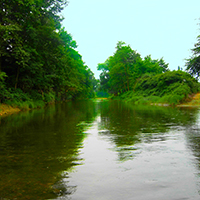Diatom communities and ecological status classification in the upper Po River basin

All claims expressed in this article are solely those of the authors and do not necessarily represent those of their affiliated organizations, or those of the publisher, the editors and the reviewers. Any product that may be evaluated in this article or claim that may be made by its manufacturer is not guaranteed or endorsed by the publisher.
Authors
One of the main challenges in river management is the setting of nutrient thresholds that support good ecological status, which is the main objective to achieve for the European member states. This is a complex process, which needs an accurate analysis of the data collected so far for the ecological classification of rivers belonging to different typologies. We analysed the data of the multiannual monitoring concerning diatoms and nutrients in the upper Po River (NW Italy) with the aim of exploring the response of diatom community in terms of species composition, ecological guilds and indices. We considered data of 390 samples, of which 2/3 belonging to the “Central macrotype” (i.e. lowland stretches) and 1/3 to “Alpine siliceous”. We performed a Principal Coordinate Analysis to detect community patterns with respect to water chemical classification and macrotypes highlighting species and ecological guilds characteristic of samples along a water quality gradient. We then performed a partial RDA to focus on the role of environmental and spatial factors in shaping the diatom community in each of the two macrotypes. Finally, we investigated the concordance between the Italian normative indices ICMi (for diatoms) and LIMECO (a chemical index of water quality). We found significant differences in the diatom communities of the two macrotypes and in their response to water quality and to spatial factors. Communities resulted as much more uniform in sites with a low water quality, with characteristic species such as Navicula gregaria, Nitzschia palea and Sellaphora nigri. On the other hands, moderately disturbed sites (in terms of trophic level) were characterised by the highest guild diversity. The RDA confirmed the importance of spatial factors in shaping the diatom assemblages, especially in Alpine streams where the physical barriers may condition species dispersion. The comparison between the two normative indices highlights that the correspondence in the classification is achieved in the 57% (Alpine macrotype) and 43% (Central macrotype) of samples. According to our findings, we suggest the revision of the ICMi, both class boundaries and reference value. In addition, we recommend to lower LIMECO threshold for total phosphorus: indeed, several studies have shown significant changes in the diatom community composition starting from very low values (below the current LIMECO threshold, i.e. 50 µgL-1). Moreover, the extension of our study to the whole Po River basin will complete our knowledge of species not yet included in the diatom indices and of the community response to nutrient levels also in other macrotypes.
ALPSTREAM - Alpine Stream Research Centre, Ostana, Italy
ALPSTREAM - Alpine Stream Research Centre, Ostana, Italy
ALPSTREAM - Alpine Stream Research Centre, Ostana, Italy
How to Cite

This work is licensed under a Creative Commons Attribution-NonCommercial 4.0 International License.






